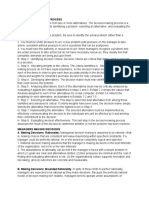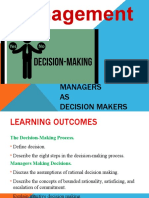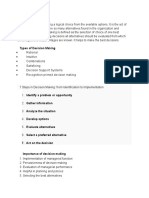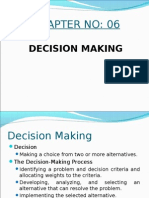0 ratings0% found this document useful (0 votes)
181 viewsNOTES CH6-Management Robbins
The document discusses decision making and the manager's role. It outlines an 8-step decision making process that includes identifying problems, criteria, alternatives, and evaluating outcomes. Managers strive for rational decision making but are bounded by constraints. They use both rational analysis and intuition. Decisions vary in structure from routine programmed decisions to complex nonprogrammed decisions. Managers also face varying conditions of certainty, risk, and uncertainty. Their style and potential biases also influence the decision making process.
Uploaded by
Salman LateefCopyright
© Attribution Non-Commercial (BY-NC)
Available Formats
Download as PDF, TXT or read online on Scribd
0 ratings0% found this document useful (0 votes)
181 viewsNOTES CH6-Management Robbins
The document discusses decision making and the manager's role. It outlines an 8-step decision making process that includes identifying problems, criteria, alternatives, and evaluating outcomes. Managers strive for rational decision making but are bounded by constraints. They use both rational analysis and intuition. Decisions vary in structure from routine programmed decisions to complex nonprogrammed decisions. Managers also face varying conditions of certainty, risk, and uncertainty. Their style and potential biases also influence the decision making process.
Uploaded by
Salman LateefCopyright
© Attribution Non-Commercial (BY-NC)
Available Formats
Download as PDF, TXT or read online on Scribd
You are on page 1/ 5
CHAPTER 7
Decision Making: The Essence of the Managers Job
THE DECISION-MAKING PROCESS
A decision is a choice made from two or more alternatives. The decision-making process is a set of
eight steps that include identifying a problem, selecting an alternative, and evaluating the
decisions effectiveness. (See Exhibit 7-1 for an illustration of the decision-making process.)
Step 1: Identifying a problem. A problem is a discrepancy between an existing and a desired
condition. In order to identify a problem, you as a manager should recognize and understand
the three characteristics of problems:
1. Be sure to identify the actual problem rather than a symptom of the problem.
2. You must be under pressure to act. A true problem puts pressure on the manager to take
action; a problem without pressure to act is a problem that can be postponed.
3. You must have the authority or resources to act. When managers recognize a problem
and are under pressure to take action but do not have necessary resources, they usually
feel that unrealistic demands are being put upon them.
Step 2: Identifying decision criteria. Decision criteria are criteria that define what is relevant in
a decision.
Step 3: Allocating weights to the criteria. The criteria identified in Step 2 of the decision-
making process do not have equal importance, so the decision maker must assign a weight to
each of the items in order to give each item accurate priority in the decision. (See Exhibit 7-2)
Step 4: Developing alternatives. The decision maker must now identify practical alternatives
that could resolve the problem.
Step 5: Analyzing alternatives. Each of the alternatives must now be critically analyzed by
evaluating it against the criteria established in steps 2 and 3. Exhibit 7-3 shows the values that
Amanda assigned to each of her alternatives for a new computer. Exhibit 7-4 reflects the
weighting for each alternative, as illustrated in Exhibits 7-2 and 7-3. (RECALL THE LECTURE)
Step 6: Selecting an alternative. This step to select the best alternative from among those
identified and assessed is important. If criteria weights have been used, the decision maker
simply selects the alternative that received the highest score in Step 5.
Step 7: Implementing the alternative. The selected alternative must be implemented by
effectively communicating the decision to the individuals who will be affected by it. If the
people who must carry out a decision participate in the process, they are more likely to
enthusiastically support the outcome. If you only tell them what is decided, support will be less.
Step 8: Evaluating decision effectiveness. This last step in the decision-making process
assesses the result of the decision to determine whether or not the problem has been resolved.
MANAGERS MAKING DECISIONS
Rationality. Managerial decision-making is assumed to be rationalthat is, making choices that
are logical, consistent and value maximizing. If a manager could be perfectly rational, he or she
would be completely logical and objective.
Assumptions of Rationality: Following are the assumptions that should be met in order to make a
decision perfectly logical decision.
The problem should be clear and unambiguous.
The goal should be well defined.
All Alternatives and their outcomes are known.
Preferences are clear, constant and stable.
No time and/or cost constraint should exist.
AND Rational decision-making assumes that the manager is making decisions in the best
interests of the organization, not in his or her own interests.
BUT these conditions are idealistic and rarely exist, therefore managers can not apply
rationality in its perfect form, they are bounded by some constraints that allow them to be
rational within certain limitations, this is the concept of Bounded rationality.
Bounded Rationality. Because the perfectly rational model of decision making isnt realistic,
managers tend to operate under assumptions of bounded rationality, which is decision-making
behavior that is rational, but limited (bounded) by an individuals ability to process information.
1. Under bounded rationality, managers make satisficing decisions (instead of value-
maximizing), in which they accept solutions that are good enough.
2. Managers decision making may be strongly influenced by the organizations culture,
internal politics, power considerations, and by a phenomenon called escalation of
commitment: an increased commitment to a previous decision despite evidence that it was wrong.
Intuition. Intuitive decision-making is a subconscious process of making decisions on the basis of
experience and accumulated judgment. (See Following Figure and memorize it.
1. Making decisions on the basis of gut feeling doesnt necessarily happen independently of
rational analysis; the two complement each other.
2. Although intuitive decision-making will not replace the rational decision-making process,
it does play an important role in managerial decision-making.
TYPES OF DECISIONS AND DECISION-MAKING CONDITIONS
Types of Decisions: Managers encounter different types of problems and use different types of
decisions to resolve them.
Structured problems are straightforward, familiar, and easily defined problems. In dealing with
structured problems, a manager may use a programmed decision, which is a repetitive
decision that can be handled by a routine approach. Managers rely on three types of programmed
decisions:
1. A procedure is a series of interrelated sequential steps that can be used to respond to a
structured problem.
2. A rule is an explicit statement that tells managers what they can or cannot do.
3. A policy is a guideline for making decisions.
Unstructured problems are problems that are new or unusual and for which information is
ambiguous or incomplete. These problems are best handled by a nonprogrammed decision that
is a unique decision that requires a custom-made solution. (There is a Figure in Book)
o At higher levels in the organizational hierarchy, managers deal more often with
difficult, unstructured problems and make nonprogrammed decisions in attempting to
resolve these problems and challenges.
o Lower-level managers handle routine decisions themselves, using programmed
decisions. They let upper-level managers handle unusual or difficult decisions.
DECISION-MAKING CONDITIONS
Certainty: is a situation in which a manager can make accurate decisions because all outcomes are
known. Few managerial decisions are made under the condition of certainty.
Risk: is a situation in which the decision maker is able to estimate the likelihood of certain outcomes.
Uncertainty: is a situation in which the decision maker is not certain and cannot even make reasonable
probability estimates concerning outcomes of alternatives.
o The choice of alternative is influenced by the limited amount of information available
to the decision maker.
o Its also influenced by the psychological orientation of the decision maker.
Since managers have no information or estimates in uncertain conditions, their decision is
influenced by their personality traits such as optimism or pessimism. In this context there can
be three approaches which are given below.
1) An optimistic manager will follow a maximax choice, maximizing the maximum
possible payoff. (Rely on Class Lecture and See Exhibit 7-10.)
2) A pessimistic manager will pursue a maximin choice, maximizing the minimum
possible payoff. (Rely on Class Lecture and See Exhibit 7-10)
3) The manager who desires to minimize the maximum regret will opt for a
minimax choice. (Rely on Class Lecture and See Exhibit 7-11)
DECISION-MAKING STYLES
Managers have different styles in making decisions and solving problems. One perspective
proposes that people differ along two dimensions in the way they approach decision making:
(1) the source of information you tend to use (Internal or External) and (2) how you process that
information (linear; rational, logical, analytical; OR nonlinearintuitive, creative, insightful).
These four dimensions are collapsed into two styles.
1. linear thinking style is characterized by a persons preference for using external data
and facts and processing this information through (linear) rational, logical thinking to
guide decisions and actions.
2. The nonlinear thinking style, is characterized by a preference for internal sources of
information and processing this information with internal insights (non-linear), feelings,
and hunches to guide decisions and actions.
DECISION-MAKING BIASES AND ERRORS
Managers use different styles and rules of thumb (heuristics) to simplify their decision
making.
1. Overconfidence bias occurs when decision makers tend to think that they know more
than they do or hold unrealistically positive views of themselves and their performance.
2. Immediate gratification bias describes decision makers who tend to want immediate
rewards and avoid immediate costs.
3. The anchoring effect describes when decision makers fixate on initial information as a
starting point and then, once set, fail to adequately adjust for subsequent information.
4. Selective perception bias occurs when decision makers selectively organize and interpret
events based on their biased perceptions.
5. Confirmation bias occurs when decision makers seek out information that reaffirms
their past choices and discount information that contradicts their past judgments.
6. Framing bias occurs when decision makers select and highlight certain aspects of a
situation while excluding others.
7. Availability bias is seen when decision makers tend to remember events that are the
most recent and vivid in their memory.
8. Decision makers who show representation bias assess the likelihood of an event based
on how closely it resembles other events or sets of events.
9. Randomness bias describes the effect when decision makers try to create meaning out of
random events.
10. The sunk costs error is when a decision maker forgets that current choices cannot correct
the past. Instead of ignoring sunk costs, the decision maker cannot forget them. In
assessing choices, the individual fixates on past expenditures rather than on future
consequences.
11. Self-serving bias is exhibited by decision makers who are quick to take credit for their
successes and blame failure on outside factors.
12. Hindsight bias is the tendency for decision makers to falsely believe, once the outcome is
known, that they would have accurately predicted the outcome.
SAMPLE QUESTIONS FOR EXAMINATION PREPARATIONS
!"# %& '()%&%*+ ,-.%+/ *01(+ '(&)2%3(' -& 1"( (&&(+)( *0 1"( ,-+-/(24& 5*36
Becisions aie maue thioughout the peifoimance of all foui functions of management. Almost
anything a managei uoes in teims of planning, oiganizing, leauing, anu contiolling involves uecision
making. The peivasiveness of uecision making in management explains why manageis aie often
calleu uecision makeis.
7*8 ,%/"1 -+ *2/-+%9-1%*+4& ):;1:2( %+0;:(+)( 1"( 8-# %+ 8"%)" ,-+-/(2& ,-.( '()%&%*+&6
An oiganization's cultuie might influence how manageis make uecisions by inuicating how much
iisk taking is peimitteu anu how much impoitance is placeu on the effectiveness of the uecisions
maue. Foi example, if an oiganizational cultuie iewaius uecisions that ieinfoice the status quo,
these types of uecisions will likely be maue.
<;; *0 :& 32%+/ 3%-&(& 1* 1"( '()%&%*+& 8( ,-.(= !"-1 1#>(& *0 3%-&(& ,%/"1 - ,-+-/(2 "-?(6
!"-1 8*:;' 3( 1"( '2-83-).& *0 "-?%+/ 3%-&(&6 @*:;' 1"(2( 3( -+# -'?-+1-/(& 1* "-?%+/
3%-&(&6 AB>;-%+= !"-1 -2( 1"( %,>;%)-1%*+& 0*2 ,-+-/(2%-; '()%&%*+ ,-.%+/6
C<DDEFGHAGIJ You (Stuuents) shoulu to iuentify biases that you have encounteieu oi feel that you
youiself might have. Examples coulu incluue anything fiom youi life expeiiences.
Bowevei, when manageis aie "#"$% of potential biases, they can use theii awaieness to an
auvantage, eithei in contiolling theii own biases oi they can bettei iecognize biases helu by otheis
anu iesponu moie effectively as a iesult of theii knowleuge. Nanageis shoulu be awaie that biases
can "clouu" a uecision makei's iuentification oi evaluation of alteinatives, which ultimately affect
the final uecision.
!*:;' #*: )-;; #*:2&(;0 - &#&1(,-1%) *2 %+1:%1%?( 1"%+.(26 !"-1 -2( 1"( '()%&%*+K,-.%+/
%,>;%)-1%*+& *0 1"(&( ;-3(;&6 !"-1 -2( 1"( %,>;%)-1%*+& 0*2 )"**&%+/ -+ (,>;*#(26
ASSIuNNENT Q0ESTI0N
L<& ,-+-/(2& :&( )*,>:1(2 -+' &*018-2( 1**;& ,*2( *01(+M 1"(#4;; 3( -3;( 1* ,-.( ,*2(
2-1%*+-; '()%&%*+&=N O* #*: -/2(( *2 '%&-/2(( 8%1" 1"-1 &1-1(,(+16 !"#6
Although computei anu softwaie tools allow manageis to gathei infoimation anu analyze it moie
efficiently, utilizing computeis uoes not necessaiily allow manageis to be moie iational. Looking at
the assumptions of iationality (see above), it is appaient that auuing computeis to the uecision-
making piocess uoes not guaiantee peifectly iational uecision making by manageis.
7*8 )-+ ,-+-/(2& 3;(+' 1"( /:%'(;%+(& 0*2 ,-.%+/ (00()1%?( '()%&%*+& %+ 1*'-#4& 8*2;' 8%1"
1"( 2-1%*+-;%1# -+' 3*:+'(' 2-1%*+-;%1# ,*'(;& *0 '()%&%*+ ,-.%+/M *2 )-+ 1"(#6 AB>;-%+=
(LAST T0PIC TB0) A balance is iequiieu. 0nuei touay's business conuitions (such as intense time
piessuie anu highei uegiees of iisk anu unceitainty), manageis must piactice sounu uecision-
making appioaches. Knowing when it's time to quit, foi example, is not inconsistent with iationality
anu bounueu iationality.
E& 1"(2( - '%00(2(+)( 3(18((+ 82*+/ '()%&%*+& -+' 3-' '()%&%*+&6 !"# '* /**' ,-+-/(2&
&*,(1%,(& ,-.( 82*+/ '()%&%*+&6 P-' '()%&%*+&6 7*8 )-+ ,-+-/(2& %,>2*?( 1"(%2 '()%&%*+K
,-.%+/ &.%;;&6
Time piessuies, incomplete infoimation, anu highei levels of unceitainty in touay's business
enviionment may leau to ineffective uecision making. Nanageis can impiove theii uecision-making
skills by focusing on six chaiacteiistics of effective uecision-making, incluuing focusing on
impoitant ciiteiia, logic anu consistency; blenuing subjective anu objective thinking with analysis;
iequiiing the infoimation necessaiy to iesolve a paiticulai uilemma; gatheiing ielevant anu
infoimeu opinions; anu iemaining flexible.
You might also like
- Test Bank For Theories of Personality 9th Edition by Feist100% (2)Test Bank For Theories of Personality 9th Edition by Feist5 pages
- Joan Ockman, Joan Ockman-The Pragmatist Imagination - Thinking About Things in The Making-Princeton Architectural Press (2001)100% (1)Joan Ockman, Joan Ockman-The Pragmatist Imagination - Thinking About Things in The Making-Princeton Architectural Press (2001)283 pages
- Case Studies in Interdisciplinary ResearchNo ratings yetCase Studies in Interdisciplinary Research2 pages
- Ethical Issues in Public Service Interpreting60% (5)Ethical Issues in Public Service Interpreting9 pages
- Chapter 7 Managers As Decision Makers AnsNo ratings yetChapter 7 Managers As Decision Makers Ans10 pages
- Chapter 6 Decision Making - The Essence of The Manager's Job100% (1)Chapter 6 Decision Making - The Essence of The Manager's Job8 pages
- Management: Managers As Decision MakersNo ratings yetManagement: Managers As Decision Makers32 pages
- Get Organizational Behavior Managing People and Organizations 11th Edition Griffin Solutions Manual Free All Chapters Available100% (14)Get Organizational Behavior Managing People and Organizations 11th Edition Griffin Solutions Manual Free All Chapters Available47 pages
- Organizational Behavior Managing People and Organizations 11th Edition Griffin Solutions Manualpdf download100% (1)Organizational Behavior Managing People and Organizations 11th Edition Griffin Solutions Manualpdf download43 pages
- Unit 3 Decision Making The Essence of Manager's JobNo ratings yetUnit 3 Decision Making The Essence of Manager's Job3 pages
- Unit 4 the Decision Making the Essence of the Manager's Job.pptxNo ratings yetUnit 4 the Decision Making the Essence of the Manager's Job.pptx25 pages
- Decision Making-Decentralization Basic Goals of DecentralizationNo ratings yetDecision Making-Decentralization Basic Goals of Decentralization18 pages
- Decision-Making: Definition: The Act of Choosing One Alternative From Among A Set of AlternativesNo ratings yetDecision-Making: Definition: The Act of Choosing One Alternative From Among A Set of Alternatives12 pages
- Organizational Behavior Managing People and Organizations 11th Edition Griffin Solutions Manual - PDF Version Is Available For Instant Access100% (2)Organizational Behavior Managing People and Organizations 11th Edition Griffin Solutions Manual - PDF Version Is Available For Instant Access49 pages
- PDF Lineamientos para Elaborar La Tesis Grados y Titulos Upsjb 1No ratings yetPDF Lineamientos para Elaborar La Tesis Grados y Titulos Upsjb 136 pages
- Decision Making The Essence of Manager's JobNo ratings yetDecision Making The Essence of Manager's Job21 pages
- Decision Making and Problem Solving - Critical CareNo ratings yetDecision Making and Problem Solving - Critical Care7 pages
- Chapter 2.Decision Making - Student CopyNo ratings yetChapter 2.Decision Making - Student Copy23 pages
- Complete Answer Guide for Organizational Behavior Managing People and Organizations 11th Edition Griffin Solutions Manual100% (2)Complete Answer Guide for Organizational Behavior Managing People and Organizations 11th Edition Griffin Solutions Manual38 pages
- Management Canadian 11th Edition Robbins Solutions Manualinstant download100% (3)Management Canadian 11th Edition Robbins Solutions Manualinstant download51 pages
- Managerial Decision Making: Dr. Amin Ullah, PHDNo ratings yetManagerial Decision Making: Dr. Amin Ullah, PHD53 pages
- Lesson 2:: Quantitative Decision MakingNo ratings yetLesson 2:: Quantitative Decision Making20 pages
- The Art of Seeing Paradox and Perception in Orthodox Iconography (Introduction)No ratings yetThe Art of Seeing Paradox and Perception in Orthodox Iconography (Introduction)20 pages
- Full Download The Realness of Things Past: Ancient Greece and Ontological History Greg Anderson PDF DOCX100% (2)Full Download The Realness of Things Past: Ancient Greece and Ontological History Greg Anderson PDF DOCX65 pages
- Magnus2021-Forall X - An Introduction To Formal LogicNo ratings yetMagnus2021-Forall X - An Introduction To Formal Logic428 pages
- Henry Sidgwick (EMT) - The Methods of EthicsNo ratings yetHenry Sidgwick (EMT) - The Methods of Ethics254 pages
- 3290 Introduction To Public Sector EthicsNo ratings yet3290 Introduction To Public Sector Ethics63 pages
- Transcendent Storytelling: Abilities For Systemic Practitioners and Their Clients W. Barnett Pearce and Kimberly A. PearceNo ratings yetTranscendent Storytelling: Abilities For Systemic Practitioners and Their Clients W. Barnett Pearce and Kimberly A. Pearce33 pages
- Glimpses of The Next State - Usborne Moore100% (1)Glimpses of The Next State - Usborne Moore273 pages
- Ib Tok 11: Here Are Some Important Knowledge Questions Concerning ReasonNo ratings yetIb Tok 11: Here Are Some Important Knowledge Questions Concerning Reason24 pages
- Harold Garfinkel: Ethnomethodology: Presented By: Emma Kehrli and Grant Robinson100% (1)Harold Garfinkel: Ethnomethodology: Presented By: Emma Kehrli and Grant Robinson27 pages
- BA-1ST (Philosophy) - Epistemology and Metaphysics (Indian and Western)No ratings yetBA-1ST (Philosophy) - Epistemology and Metaphysics (Indian and Western)104 pages
- Frontier Thinkers of Education and Some Filipino Educators SocratesNo ratings yetFrontier Thinkers of Education and Some Filipino Educators Socrates10 pages
- Gilbert Simondon and The Philosophy of Information: An Interview With Jean-Hugues BarthélémyNo ratings yetGilbert Simondon and The Philosophy of Information: An Interview With Jean-Hugues Barthélémy12 pages
- Test Bank For Theories of Personality 9th Edition by FeistTest Bank For Theories of Personality 9th Edition by Feist
- Joan Ockman, Joan Ockman-The Pragmatist Imagination - Thinking About Things in The Making-Princeton Architectural Press (2001)Joan Ockman, Joan Ockman-The Pragmatist Imagination - Thinking About Things in The Making-Princeton Architectural Press (2001)
- Chapter 6 Decision Making - The Essence of The Manager's JobChapter 6 Decision Making - The Essence of The Manager's Job
- Get Organizational Behavior Managing People and Organizations 11th Edition Griffin Solutions Manual Free All Chapters AvailableGet Organizational Behavior Managing People and Organizations 11th Edition Griffin Solutions Manual Free All Chapters Available
- Organizational Behavior Managing People and Organizations 11th Edition Griffin Solutions Manualpdf downloadOrganizational Behavior Managing People and Organizations 11th Edition Griffin Solutions Manualpdf download
- Unit 3 Decision Making The Essence of Manager's JobUnit 3 Decision Making The Essence of Manager's Job
- Unit 4 the Decision Making the Essence of the Manager's Job.pptxUnit 4 the Decision Making the Essence of the Manager's Job.pptx
- Decision Making-Decentralization Basic Goals of DecentralizationDecision Making-Decentralization Basic Goals of Decentralization
- Decision-Making: Definition: The Act of Choosing One Alternative From Among A Set of AlternativesDecision-Making: Definition: The Act of Choosing One Alternative From Among A Set of Alternatives
- Organizational Behavior Managing People and Organizations 11th Edition Griffin Solutions Manual - PDF Version Is Available For Instant AccessOrganizational Behavior Managing People and Organizations 11th Edition Griffin Solutions Manual - PDF Version Is Available For Instant Access
- PDF Lineamientos para Elaborar La Tesis Grados y Titulos Upsjb 1PDF Lineamientos para Elaborar La Tesis Grados y Titulos Upsjb 1
- Decision Making and Problem Solving - Critical CareDecision Making and Problem Solving - Critical Care
- Complete Answer Guide for Organizational Behavior Managing People and Organizations 11th Edition Griffin Solutions ManualComplete Answer Guide for Organizational Behavior Managing People and Organizations 11th Edition Griffin Solutions Manual
- Management Canadian 11th Edition Robbins Solutions Manualinstant downloadManagement Canadian 11th Edition Robbins Solutions Manualinstant download
- The Art of Seeing Paradox and Perception in Orthodox Iconography (Introduction)The Art of Seeing Paradox and Perception in Orthodox Iconography (Introduction)
- Full Download The Realness of Things Past: Ancient Greece and Ontological History Greg Anderson PDF DOCXFull Download The Realness of Things Past: Ancient Greece and Ontological History Greg Anderson PDF DOCX
- Magnus2021-Forall X - An Introduction To Formal LogicMagnus2021-Forall X - An Introduction To Formal Logic
- Transcendent Storytelling: Abilities For Systemic Practitioners and Their Clients W. Barnett Pearce and Kimberly A. PearceTranscendent Storytelling: Abilities For Systemic Practitioners and Their Clients W. Barnett Pearce and Kimberly A. Pearce
- Ib Tok 11: Here Are Some Important Knowledge Questions Concerning ReasonIb Tok 11: Here Are Some Important Knowledge Questions Concerning Reason
- Harold Garfinkel: Ethnomethodology: Presented By: Emma Kehrli and Grant RobinsonHarold Garfinkel: Ethnomethodology: Presented By: Emma Kehrli and Grant Robinson
- BA-1ST (Philosophy) - Epistemology and Metaphysics (Indian and Western)BA-1ST (Philosophy) - Epistemology and Metaphysics (Indian and Western)
- Frontier Thinkers of Education and Some Filipino Educators SocratesFrontier Thinkers of Education and Some Filipino Educators Socrates
- Gilbert Simondon and The Philosophy of Information: An Interview With Jean-Hugues BarthélémyGilbert Simondon and The Philosophy of Information: An Interview With Jean-Hugues Barthélémy

























































































